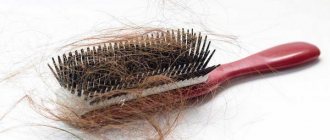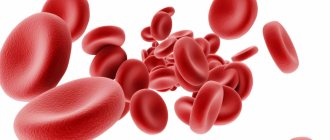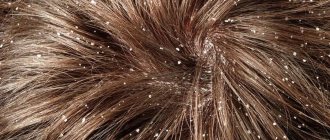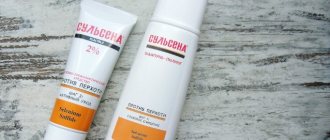What causes dandruff
There are several factors that can determine the formation of dandruff. This does not mean at all that if they are present, a person will necessarily develop dandruff, but they can “push” the process.
When a person is predisposed to dandruff:
- heredity - if relatives suffered from this disease;
- excessive work of the sebaceous glands and excessive secretion of sebum;
- diseases of the nervous system, such as paresis or Parkinson's disease;
- taking certain medications;
- severe stress and emotional overload;
- gastrointestinal diseases, dysbiosis, enzyme imbalance;
- avitaminosis;
- endocrine diseases, such as diabetes or Cushing's disease;
- improper hair care, use of inappropriate products and styling methods.
In some cases, dandruff may be the first manifestation of a skin disease - seborrheic dermatitis.
Seborrheic dermatitis
This is the general name for diseases associated with the increased proliferation of the fungus Malassezia Furfur, in which all of the above symptoms occur, and crust-like formations appear on the skin, which are flaky and itchy, which can result in significant redness of the skin. Seborrheic dermatitis can sometimes be accompanied by other diseases of an infectious (for example, lichen) and non-infectious (neurodermatitis, psoriasis) nature, so the patient also needs to be checked for their presence. The reasons for its appearance are the same as for other types of seborrhea (6).
Why does dandruff appear in children?
Not only adults, but also children of different ages suffer from dandruff. In infants, this is due to insufficient development of the sebaceous glands. Sometimes it appears during breastfeeding in the form of an allergy to foods consumed by the mother. It can also appear due to the wrong bathing product or shampoo.
Dandruff is also common in teenagers. This is explained by the fact that during puberty, the sebaceous glands work in an enhanced mode and produce too much sebum.
How does dandruff appear?
This syndrome has its own symptoms:
- greasy shine of the scalp and hair;
- peeling and a large number of skin flakes on the hair;
- constant itching;
- hair loss;
- sometimes – red spots on the scalp.
Skin flakes stick to the hair at the base. They are thin, almost transparent, white, grayish or yellowish. They can accumulate on any part of the head, and are distributed unevenly - somewhere more, somewhere less. If your hair is collected in a braid or bun, there is usually the most dandruff under it in this place. When combing or even just moving the head, the scales fall off.
Oily seborrhea
The production of excess sebum leads to a decrease in the amount of antibacterial substances in the secretion. This creates a favorable environment for the growth of colonies of the Malassezia fungus. As a result of the activity of the fungus, the epidermis begins to peel off and greasy dandruff forms. Characteristic symptoms of oily seborrhea: greasy hair, which in its advanced form can even stick together, and itching. Unlike dry dandruff, oily dandruff does not flake off the skin so easily.
In some cases, an acne-like rash or even individual boils are observed, the skin becomes crusty, bloody discharge appears when scratching, and if treatment is not carried out, the person’s hair will begin to fall out over time. This disease, associated with increased activity of the sebaceous glands, can occur not only on the scalp, but also on the face, most often in the nasolabial triangle, between the lower lip and chin, and behind the ears. Oily seborrhea on the face manifests itself in the form of open pores and graying of the skin, which is due to the fact that dirt and dust flying in the air settle on the skin.
The most common cause of oily seborrhea is hormonal. And indeed: the production of large amounts of sebum is almost always accompanied by strong hormonal changes, for example, during puberty. At the same time, oily dandruff most often occurs in teenage boys and men, since the increased work of the sebaceous glands is provoked mainly by male hormones. Normally, this disease is temporary and goes away in the vast majority of patients by the age of 25, but in 10% it becomes chronic (4). Among other reasons for the appearance of oily dandruff, we highlight genetic, while the hereditary factor in the occurrence of this disease is often put in first place. Oily seborrhea can also be caused by:
- frequent stress;
- taking hormonal medications;
- diseases of the nervous system;
- diseases of the gastrointestinal tract;
- diseases of the genitourinary system
Why does dandruff occur?
As mentioned above, this is the result of fungal activity. It parasitizes on fatty environments. The fungus produces lipases and phospholipases to break down sebum and produce the fatty acids it needs to live. The fungus also produces extracellular proteins that enter the skin and lead to the formation of dandruff.
Under normal conditions, epidermal cells live 25–30 days. When pathology occurs, their physiological cycle is shortened to 5–14 days. In such a short period of time, cells cannot normally go through the entire development cycle, do not lose moisture, and therefore stick together. They do not peel off individually, as they should normally, but in flakes. This is dandruff.
Treatment methods
The main task in the treatment of dandruff is to eliminate the cause that causes it, seborrhea, and also to minimize the influence of the factors that caused the appearance of the latter. With the right treatment, the main symptoms of dandruff – flaking and itching – will go away fairly quickly. Procedures can be divided into two types: therapeutic and preventive. After the treatment prescribed by the trichologist, prevention is necessary so that seborrhea does not return. This is especially important if it is impossible to eliminate the cause of seborrhea (for example, heredity or chronic diseases).
One of the most effective drugs for combating any type of dandruff is the antifungal substance ketoconazole. (7) It suppresses the activity of the Malassezia fungus, an increase in the number of which leads to the occurrence of various types of seborrhea and the appearance of dandruff. Ketoconazole is included in some medicinal shampoos and, in particular, “Perhotala”, which is available in two forms: with 2% ketoconazole for treatment and with 1% ketoconazole for prevention. A serious advantage of ketoconazole is that it relieves symptoms of concomitant infectious diseases, for example, pityriasis versicolor, which has been clinically proven. (8)
Types of dandruff
There are three varieties:
- Fat. It appears when there is an excess of sebum, which covers the skin and hair, causing them to become greasy and acquire a characteristic shine. Oily seborrhea can be thick or thin. When thick, skin scales stick to each other and cover the scalp, on which comedones appear - blackheads in which sebaceous mass accumulates. With liquid dandruff, the pores on the scalp expand, creating an “orange peel” effect.
- Dry. This form occurs when not enough sebum is produced because it is too viscous. When the hair becomes too dry, it becomes brittle and thin. Dandruff flakes come off easily.
- Mixed . At the same time, there are signs of both dry and oily seborrhea in different areas.
Tubular seborrhea
This type of seborrhea is characterized by the fact that dandruff appears not on the scalp, but on the hair. This is explained by the fact that the Malassezia fungus in this case begins to multiply on the hairline. Dandruff, characteristic of tubular seborrhea, appears in the form of small white grains of sand, which can be confused with nits. Also, tubular seborrhea is accompanied by severe itching and redness of the scalp. It occurs most often in adolescents, since its appearance is associated with hormonal changes in the body.
Is dandruff a consequence of improper care?
Contrary to popular belief, dandruff is not only the result of infrequent hair washing. Poor hygiene can make dandruff worse. It often appears due to the fact that when using styling products, they are not completely washed off from the hair and scalp. The skin is not cleaned properly. Particles of styling products block the sebaceous glands and the balance is disrupted. This leads to the appearance of dandruff on the head.
Excessive hair care can also cause dandruff. If the shampoo is aggressive or simply not suitable for the hair, the skin will dry out, which can also lead to dandruff.
Another problem can arise when you eat in the cold, neglect hats, or, conversely, overheat your head, for example, on the beach, in a solarium, or in a bathhouse. Everything needs moderation.
The structure of the skin and its appendages
Skin is a part of the body that performs many functions:
- Protective. A function that protects the body from harmful influences - chemical, mechanical, hypothermia and overheating, etc.
- Respiratory. The surface of the skin makes 2% of the total “breathing” of the entire human body.
- Regulatory. Mineral and water balances, thermoregulation (due to sweating) are carried out by this function.
The skin consists of three components:
- Epidermis is the outer layer.
- The dermis, that is, the skin itself, is an intermediate layer (connective tissue). The dermis is the support for blood vessels, nerves and skin appendages.
- The hypodermis is the layer that lies deeper than the others.
Hair, sebaceous, sweat glands are skin appendages on the head.
Epidermis
Several layers make up the epidermis. Cells originate in the basal layer, some of them continuously move towards the stratum corneum, changing their appearance along the way and, at the final stage, losing their nucleus. By the end of the movement, these cells become keratinized, nuclear-free scales that form the stratum corneum.
These scales are constantly replaced by others that rise from the basal layer. This is how skin regeneration or renewal occurs. Melanin, which determines the color of hair and skin, is produced by cells located in the cuticle. And the immune system of the skin is macrophages.
Dermis
A set of bundles of connective tissue and elastic fibers, which is the dermis, helps maintain the shape of the skin, that is, stretch and contract without visible changes.
Here are located:
- nerves;
- hair follicles;
- vessels;
- sweat and sebaceous glands.
Sweat creates comfortable thermoregulation and removes dangerous substances from the body. The sebaceous glands have an equally important function. They produce sebum, which protects against hypothermia and drying out, and prevents the dermis from cracking.
Hypodermis
The layer that is located deeper than the others. This is where blood vessels and nerve trunks are located. The thickness of the hypodermis on the head is about 2 mm.
Why is dandruff dangerous?
Dandruff itself is not a disease. But if the reasons for its appearance are not dealt with and treated, it can lead to complications. Under certain factors, it can develop into sebopsoriasis. This is a skin condition that precedes psoriasis. With it, not only the scalp flakes, the peeling also spreads to the eyebrows and the whole body.
If dandruff persists for a long time, it develops into seborrheic dermatitis. This is a chronic inflammatory disease that requires serious treatment.
If dandruff is left untreated, the flakes will block the supply of oxygen to the hair follicles. Because of this, the hair becomes thin and weak, splits, and falls out. In advanced cases, the hair follicles die and there is a risk of baldness.
Dandruff is accompanied by itching. If you constantly scratch your head, you can introduce staphylococci or streptococci into the scratches, which leads to furunculosis, folliculitis, abscesses and other purulent skin diseases.
Dandruff flakes can block the ducts of the sebaceous glands. In this case, secretion will accumulate inside the duct, and a cyst will appear - atheroma. It is opened surgically.
Is dandruff contagious or not?
Trichologists answer this question as follows: seborrhea itself is not an infectious disease, but this disorder occurs due to fungal activity, and fungi (including Malassezia) are transmitted from person to person. Nevertheless, Malassezia is found in the microflora of the skin of every person, and its activity is not associated with infection, but with disruption of the sebaceous glands, which can be caused by various reasons, mainly of a non-infectious nature. [12], [13], [14]
How to treat dandruff
For treatment to be successful, it is necessary to remove scales, get rid of itching and normalize the activity of Malassezia fungi. Since dandruff occurs when the sebaceous glands do not function properly, it means that it is necessary to reduce the production of sebum. Taking this into account, effective products for the treatment of dandruff must contain components that have antifungal and sebum-regulating effects.
Products from the Sulsen series contain selenium disulfide, which suppresses the activity of yeast fungi that cause dandruff. These medications also help restore a healthy balance to the scalp. They contain natural ingredients, saturate and nourish the scalp, making it healthy and hair beautiful. The series includes various products - shampoos, peeling, cream, oil. Everyone can choose convenient hair and head care products. They are easy to use. The effect is achieved quickly, but they can also be used for preventive purposes. Sulsena will help you get rid of dandruff easily.
Features of diagnosing hair fungus
A specialist can determine the presence and type of fungus relatively easily and reliably with the help of laboratory tests using microscopic and cultural methods. The first involves taking hair and skin flakes from the patient to examine for the presence of mycelial spores, gas bubbles, and fragments of large mushrooms. The cultural method is used if the presence of a fungus is nevertheless detected and allows one to determine the specific type of mycelium that has colonized the patient’s scalp. To do this, the detected fungus is grown in a nutrient medium, after which the grown colony is examined, in particular, the growth pattern is assessed (the process takes several days).
One of the modern tools used to determine mycosis is a Wood's lamp. The device emits a wave of a certain length and allows you to illuminate the colonies, giving an idea of the size and location, but not providing an answer regarding the type of microorganism, and therefore the treatment tactics.










